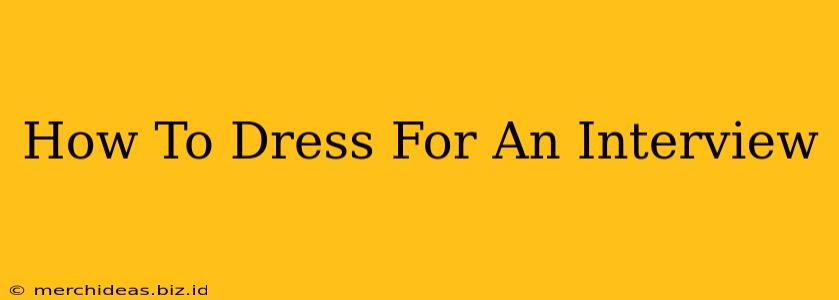Landing that dream job often hinges on more than just your skills and experience; it's about making a strong first impression. And a significant part of that first impression is how you dress for the interview. Knowing how to dress appropriately demonstrates respect for the interviewer and the company, showcasing your professionalism and attention to detail. This guide will help you navigate the sometimes tricky waters of interview attire, ensuring you look and feel your best.
Understanding the Company Culture
Before you even think about what to wear, research the company culture. A startup might have a more relaxed dress code than a traditional law firm. Check out their website, social media, and even LinkedIn profiles of employees to get a feel for their typical attire. This research will help you make an informed decision about your outfit.
Casual vs. Business Casual vs. Business Formal: What's the Difference?
-
Casual: Think comfortable yet put-together. This might include clean jeans (no rips or distressing), a nice blouse or polo shirt, and comfortable but presentable shoes. This is rarely appropriate for a job interview. Only consider this if the company explicitly states a casual dress code and the role is very informal (e.g., some creative fields).
-
Business Casual: This is a safe bet for most interviews. It allows for some personality while maintaining professionalism. Examples include:
- For Women: Khakis or dress pants, a blouse, a skirt and a sweater or blazer, and closed-toe shoes.
- For Men: Khakis or dress pants, a button-down shirt (can be long or short-sleeved), a blazer (optional but recommended), and dress shoes.
-
Business Formal: This is the most conservative option and is suitable for interviews in highly traditional industries (e.g., finance, law, government). This includes:
- For Women: A pantsuit or skirt suit, a blouse, conservative jewelry, and closed-toe shoes with a low heel.
- For Men: A suit (dark-colored is best), a dress shirt, a tie, and dress shoes.
Key Considerations for Your Interview Outfit
Fit and Grooming:
- Clothes should fit well: Avoid anything too tight or too loose. Well-fitting clothes will make you look more polished and professional.
- Iron your clothes: Wrinkles are a major no-no. Make sure your outfit is wrinkle-free and clean.
- Pay attention to details: Ensure your shoes are clean and polished, and your accessories (if any) are minimal and understated.
- Grooming matters: Maintain good hygiene, keep your hair neat, and avoid overpowering perfumes or colognes.
Color Choices:
- Neutral colors are best: Darker colors such as navy, black, gray, or charcoal are generally recommended. These project professionalism and confidence.
- Avoid bright or flashy colors: These can be distracting and unprofessional.
Accessories:
- Keep it minimal: Avoid excessive jewelry or accessories. A simple watch and a subtle necklace or earrings are generally sufficient.
What NOT to Wear to an Interview
- Anything too revealing: Avoid anything low-cut, short, or overly tight.
- Anything too casual: Jeans, t-shirts, sneakers, and flip-flops are generally inappropriate.
- Clothes with logos or slogans: These can be distracting and unprofessional.
- Distracting jewelry: Keep it simple and understated.
After You've Chosen Your Outfit
- Try it on ahead of time: This will help you ensure everything fits and looks good together.
- Prepare the night before: This will help avoid last-minute stress and ensure you're ready to go.
By carefully considering these tips, you can ensure your outfit helps you make a positive and memorable first impression. Remember, your attire is just one element of a successful interview, but it's an important one! Good luck!
